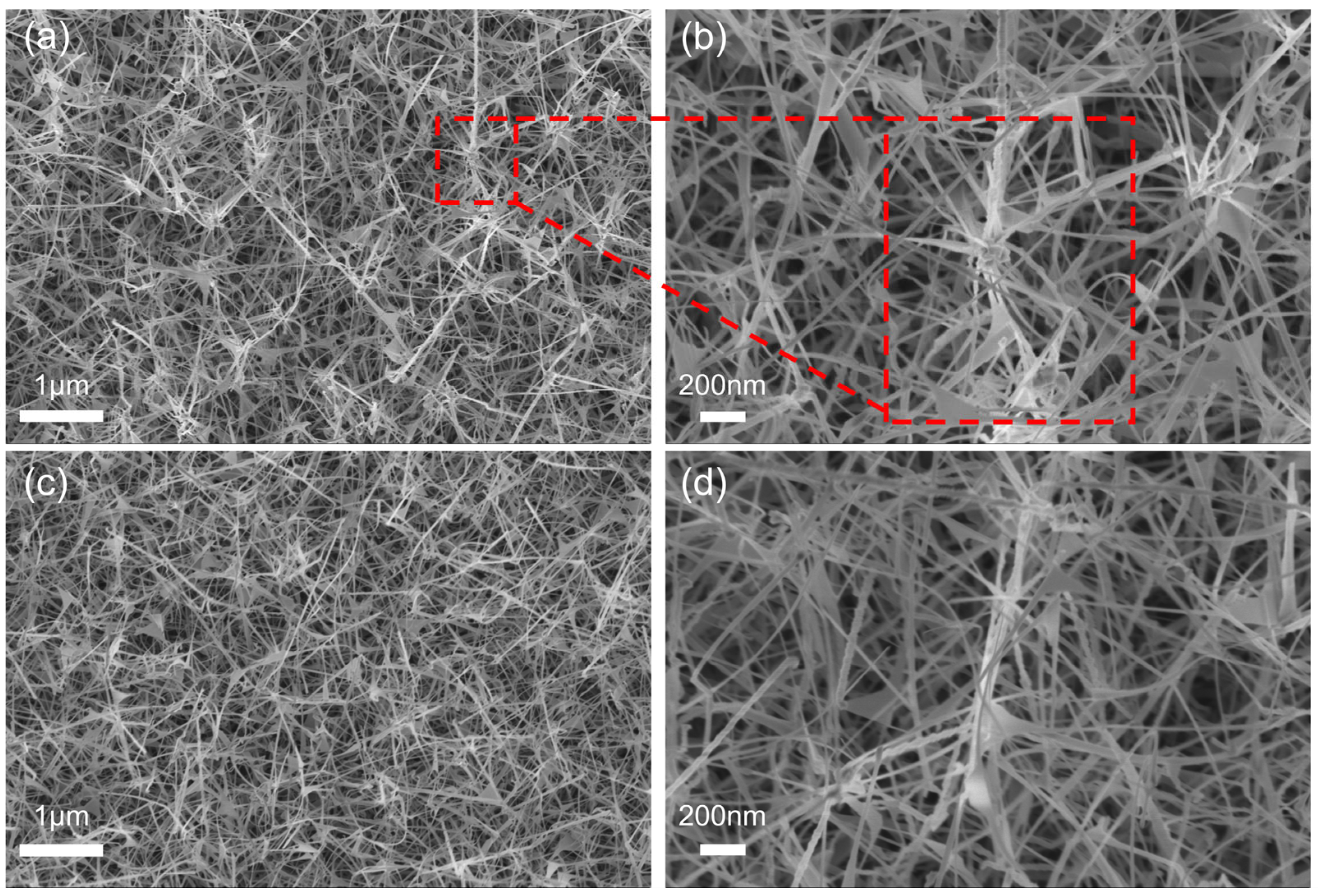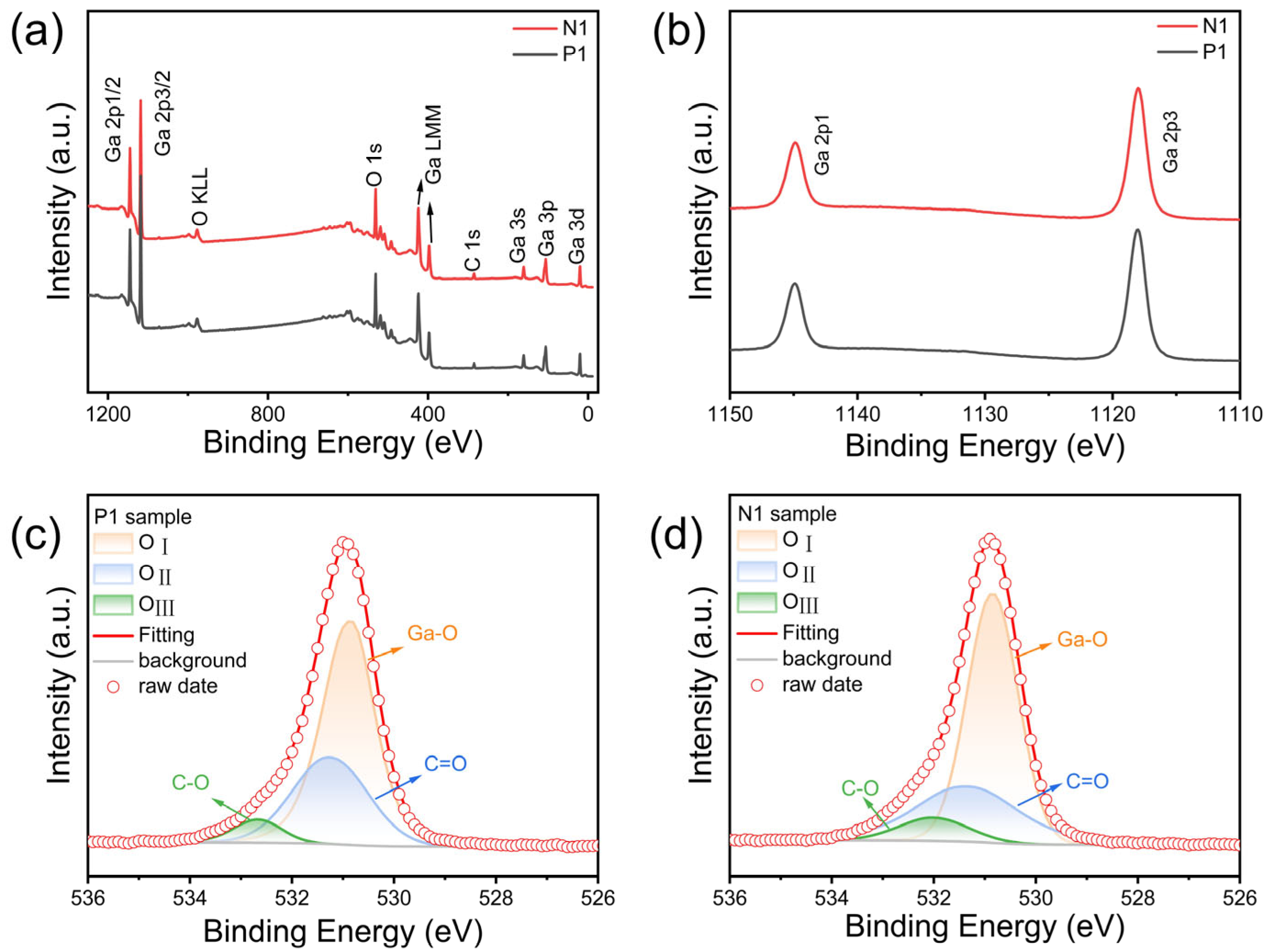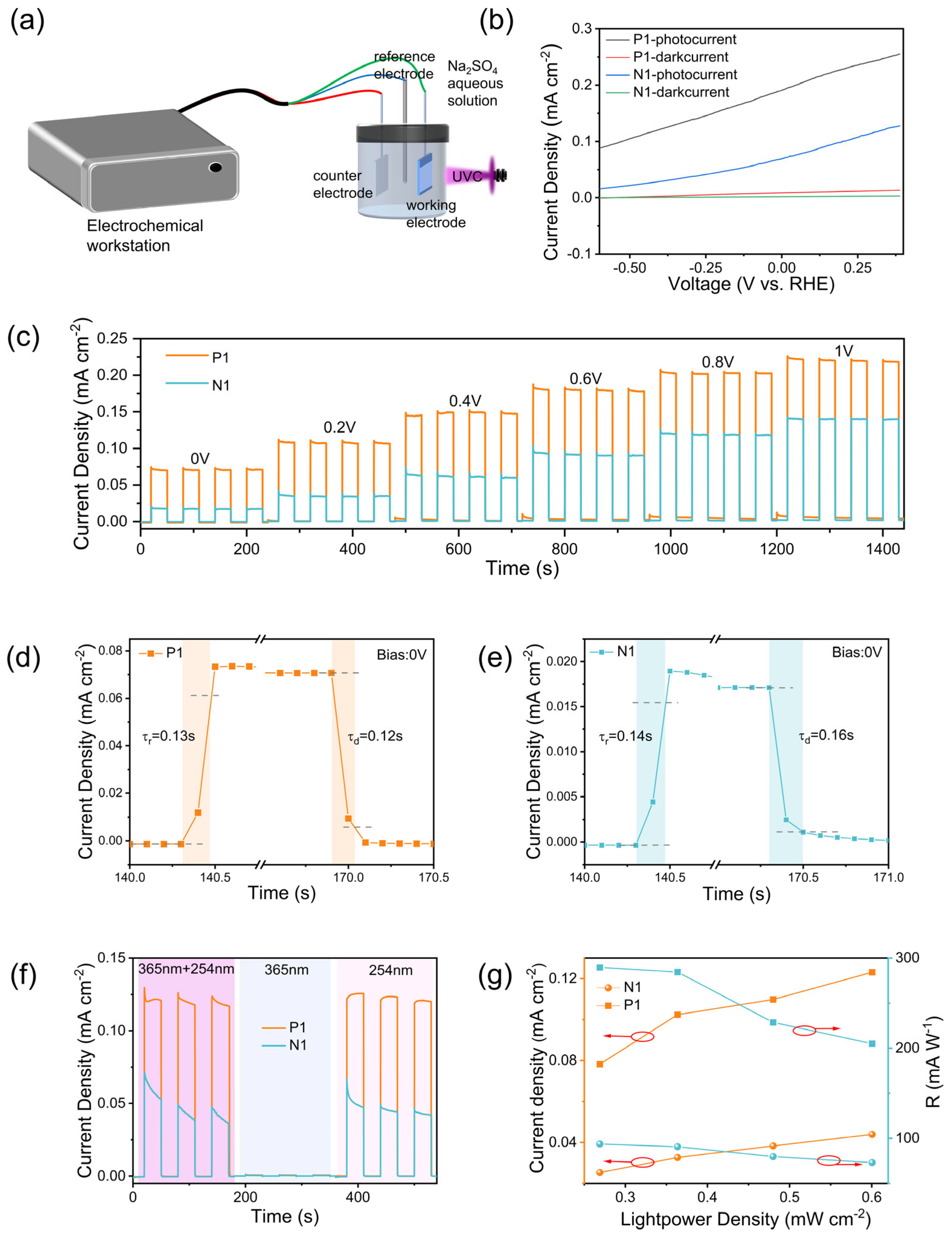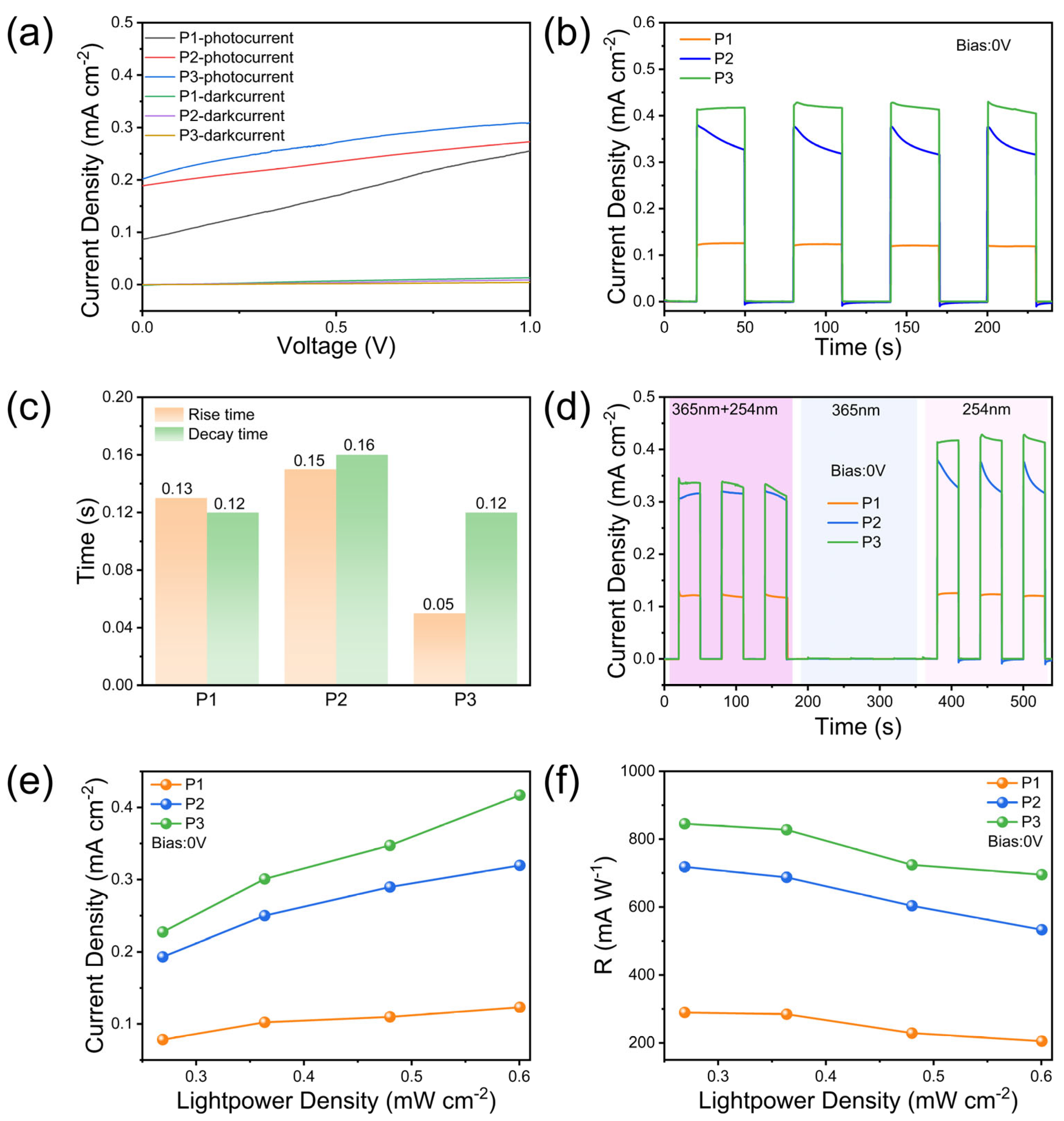Enhancing the Performance of Si/Ga2O3 Heterojunction Solar-Blind Photodetectors for Underwater Applications
Abstract
1. Introduction
2. Materials and Methods
3. Result and Discussion
4. Conclusions
Author Contributions
Funding
Data Availability Statement
Conflicts of Interest
References
- Xu, J.; Zheng, W.; Huang, F. Gallium oxide solar-blind ultraviolet photodetectors: A review. J. Mater. Chem. C 2019, 7, 8753–8770. [Google Scholar] [CrossRef]
- Qin, Y.; Long, S.; Dong, H.; He, Q.; Jian, G.; Zhang, Y.; Hou, X.; Tan, P.; Zhang, Z.; Lv, H.; et al. Review of deep ultraviolet photodetector based on gallium oxide. Chin. Phys. B 2019, 28, 018501. [Google Scholar] [CrossRef]
- Guo, D.; Su, Y.; Shi, H.; Li, P.; Zhao, N.; Ye, J.; Wang, S.; Liu, A.; Chen, Z.; Li, C.; et al. Self-Powered Ultraviolet Photodetector with Superhigh Photoresponsivity (3.05 A/W) Based on the GaN/Sn:Ga2O3 pn Junction. ACS Nano 2018, 12, 12827–12835. [Google Scholar] [CrossRef] [PubMed]
- Luo, Y.; Wang, D.; Kang, Y.; Liu, X.; Fang, S.; Memon, M.H.; Yu, H.; Zhang, H.; Luo, D.; Sun, X.; et al. Demonstration of Photoelectrochemical-Type Photodetectors Using Seawater as Electrolyte for Portable and Wireless Optical Communication. Adv. Opt. Mater. 2022, 10, 2102839. [Google Scholar] [CrossRef]
- Cai, Q.; You, H.; Guo, H.; Wang, J.; Liu, B.; Xie, Z.; Chen, D.; Lu, H.; Zheng, Y.; Zhang, R. Progress on AlGaN-based solar-blind ultraviolet photodetectors and focal plane arrays. Light Sci. Appl. 2021, 10, 94. [Google Scholar] [CrossRef] [PubMed]
- Kapp, F.G.; Perlin, J.R.; Hagedorn, E.J.; Gansner, J.M.; Schwarz, D.E.; O’Connell, L.A.; Johnson, N.S.; Amemiya, C.; Fisher, D.E.; Wolfle, U.; et al. Protection from UV light is an evolutionarily conserved feature of the haematopoietic niche. Nature 2018, 558, 445–448. [Google Scholar] [CrossRef]
- Wang, D.; Liu, X.; Fang, S.; Huang, C.; Kang, Y.; Yu, H.; Liu, Z.; Zhang, H.; Long, R.; Xiong, Y.; et al. Pt/AlGaN Nanoarchitecture: Toward High Responsivity, Self-Powered Ultraviolet-Sensitive Photodetection. Nano Lett. 2021, 21, 120–129. [Google Scholar] [CrossRef]
- Zhang, D.; Zheng, W.; Lin, R.; Li, Y.; Huang, F. Ultrahigh EQE (15%) Solar-Blind UV Photovoltaic Detector with Organic–Inorganic Heterojunction via Dual Built-In Fields Enhanced Photogenerated Carrier Separation Efficiency Mechanism. Adv. Funct. Mater. 2019, 29, 1900935. [Google Scholar] [CrossRef]
- Zhou, J.; Chen, L.; Wang, Y.; He, Y.; Pan, X.; Xie, E. An overview on emerging photoelectrochemical self-powered ultraviolet photodetectors. Nanoscale 2016, 8, 50–73. [Google Scholar] [CrossRef]
- Park, S.; Heo, S.W.; Lee, W.; Inoue, D.; Jiang, Z.; Yu, K.; Jinno, H.; Hashizume, D.; Sekino, M.; Yokota, T.; et al. Self-powered ultra-flexible electronics via nano-grating-patterned organic photovoltaics. Nature 2018, 561, 516–521. [Google Scholar] [CrossRef]
- Liu, X.; Gao, H.; Ward, J.E.; Liu, X.; Yin, B.; Fu, T.; Chen, J.; Lovley, D.R.; Yao, J. Power generation from ambient humidity using protein nanowires. Nature 2020, 578, 550–554. [Google Scholar] [CrossRef]
- Song, W.; Chen, J.; Li, Z.; Fang, X. Self-Powered MXene/GaN van der Waals Heterojunction Ultraviolet Photodiodes with Superhigh Efficiency and Stable Current Outputs. Adv. Mater. 2021, 33, 2101059. [Google Scholar] [CrossRef]
- Cheng, L.; Zhu, Y.; Wang, W.; Zheng, W. Strong Electron-Phonon Coupling in β-Ga2O3: A Huge Broadening of Self-Trapped Exciton Emission and a Significant Red Shift of the Direct Bandgap. J. Phys. Chem. Lett. 2022, 13, 3053–3058. [Google Scholar] [CrossRef]
- Oh, S.; Kim, C.-K.; Kim, J. High Responsivity β-Ga2O3 Metal-Semiconductor-Metal Solar-Blind Photodetectors with Ultraviolet Transparent Graphene Electrodes. ACS Photonics 2017, 5, 1123–1128. [Google Scholar] [CrossRef]
- Chen, K.; Wang, S.; He, C.; Zhu, H.; Zhao, H.; Guo, D.; Chen, Z.; Shen, J.; Li, P.; Liu, A.; et al. Photoelectrochemical Self-Powered Solar-Blind Photodetectors Based on Ga2O3 Nanorod Array/Electrolyte Solid/Liquid Heterojunctions with a Large Separation Interface of Photogenerated Carriers. ACS Appl. Nano Mater. 2019, 2, 6169–6177. [Google Scholar] [CrossRef]
- Huang, L.; Hu, Z.; He, X.; Ma, T.; Li, M.; Zhang, H.; Xiong, Y.; Kong, C.; Ye, L.; Li, H.; et al. Self-powered solar-blind ultraviolet photodetector based on α-Ga2O3 nanorod arrays fabricated by the water bath method. Opt. Mater. Express 2021, 11, 2089–2098. [Google Scholar] [CrossRef]
- Feng, Y.; Lv, L.; Zhang, H.; Ye, L.; Xiong, Y.; Fang, L.; Kong, C.; Li, H.; Li, W. Catalyst-Free β-Ga2O3@a-Ga2O3 Core-Shell nanorod arrays grown on Si substrate for High-performance self-powered solar-blind photoelectrochemical photodetection. Appl. Surf. Sci. 2023, 624, 157149. [Google Scholar] [CrossRef]
- Huang, L.; Hu, Z.; Zhang, H.; Xiong, Y.; Fan, S.; Kong, C.; Li, W.; Ye, L.; Li, H. A simple, repeatable and highly stable self-powered solar-blind photoelectrochemical-type photodetector using amorphous Ga2O3 films grown on 3D carbon fiber paper. J. Mater. Chem. C 2021, 9, 10354–10360. [Google Scholar] [CrossRef]
- Zhang, J.; Jiao, S.; Wang, D.; Gao, S.; Wang, J.; Zhao, L. Nano tree-like branched structure with α-Ga2O3 covered by γ-Al2O3 for highly efficient detection of solar-blind ultraviolet light using self-powered photoelectrochemical method. Appl. Surf. Sci. 2021, 541, 148380. [Google Scholar] [CrossRef]
- Greczynski, G.; Hultman, L. C 1s Peak of Adventitious Carbon Aligns to the Vacuum Level: Dire Consequences for Material’s Bonding Assignment by Photoelectron Spectroscopy. ChemPhysChem. 2017, 18, 1507–1512. [Google Scholar] [CrossRef]
- Kim, K.T.; Jin, H.J.; Choi, W.; Jeong, Y.; Shin, H.G.; Lee, Y.; Kim, K.; Im, S. High Performance β-Ga2O3 Schottky Barrier Transistors with Large Work Function TMD Gate of NbS2 and TaS2. Adv. Funct. Mater. 2021, 31, 2010303. [Google Scholar] [CrossRef]
- Greczynski, G.; Hultman, L. Reliable determination of chemical state in x-ray photoelectron spectroscopy based on sample-work-function referencing to adventitious carbon: Resolving the myth of apparent constant binding energy of the C 1s peak. Appl. Surf. Sci. 2018, 451, 99–103. [Google Scholar] [CrossRef]
- Greczynski, G.; Hultman, L. X-ray photoelectron spectroscopy: Towards reliable binding energy referencing. Prog. Mater. Sci. 2020, 107, 100591. [Google Scholar] [CrossRef]
- Wang, D.; Ma, X.; Xiao, H.; Chen, R.; Le, Y.; Luan, C.; Zhang, B.; Ma, J. Effect of epitaxial growth rate on morphological, structural and optical properties of β-Ga2O3 films prepared by MOCVD. Mater. Res. Bull. 2022, 149, 111718. [Google Scholar] [CrossRef]
- Chen, X.; Mi, W.; Wu, J.; Yang, Z.; Zhang, K.; Zhao, J.; Luan, C.; Wei, Y. A solar-blind photodetector based on β-Ga2O3 film deposited on MgO (100) substrates by RF magnetron sputtering. Vacuum 2020, 180, 109632. [Google Scholar] [CrossRef]
- Nie, Y.; Jiao, S.; Li, S.; Lu, H.; Liu, S.; Yang, S.; Wang, D.; Gao, S.; Wang, J.; Li, Y. Modulating the blue and green luminescence in the β-Ga2O3 films. J. Alloys Compd. 2022, 900, 163431. [Google Scholar] [CrossRef]
- Li, S.; Yue, J.; Ji, X.; Lu, C.; Yan, Z.; Li, P.; Guo, D.; Wu, Z.; Tang, W. Oxygen vacancies modulating the photodetector performances in ε-Ga2O3 thin films. J. Mater. Chem. C 2021, 9, 5437–5444. [Google Scholar] [CrossRef]
- Peng, K.; Xue, D.; Lin, W.; Lv, P. Amorphous Ga2O3-based solar-blind photodetectors on crystalline and amorphous substrates: A comparative study. Mater. Sci. Semicond. Process. 2024, 179, 108491. [Google Scholar] [CrossRef]
- Cheng, Y.; Ye, J.; Lai, L.; Fang, S.; Guo, D. Ambipolarity Regulation of Deep-UV Photocurrent by Controlling Crystalline Phases in Ga2O3 Nanostructure for Switchable Logic Applications. Adv. Electron. Mater. 2023, 9, 2201216. [Google Scholar] [CrossRef]
- Zhang, Y.; Zhang, F.; Xu, Y.; Huang, W.; Wu, L.; Zhang, Y.; Zhang, X.; Zhang, H. Self-Healable Black Phosphorus Photodetectors. Adv. Funct. Mater. 2019, 29, 1906610. [Google Scholar] [CrossRef]
- Li, Y.; Zheng, W.; Huang, F. All-silicon photovoltaic detectors with deep ultraviolet selectivity. PhotoniX 2020, 1, 15. [Google Scholar] [CrossRef]
- Wang, D.; Huang, C.; Liu, X.; Zhang, H.; Yu, H.; Fang, S.; Ooi, B.S.; Mi, Z.; He, J.H.; Sun, H. Highly Uniform, Self-Assembled AlGaN Nanowires for Self-Powered Solar-Blind Photodetector with Fast-Response Speed and High Responsivity. Adv. Opt. Mater. 2020, 9, 2000893. [Google Scholar] [CrossRef]
- Zeng, L.; Tao, L.; Tang, C.; Zhou, B.; Long, H.; Chai, Y.; Lau, S.P.; Tsang, Y.H. High-responsivity UV-Vis Photodetector Based on Transferable WS2 Film Deposited by Magnetron Sputtering. Sci. Rep. 2016, 6, 20343. [Google Scholar] [CrossRef]
- Zhang, N.; Lin, Z.; Wang, Z.; Zhu, S.; Chen, D.; Qi, H.; Zheng, W. Under-Seawater Immersion β-Ga2O3 Solar-Blind Ultraviolet Imaging Photodetector with High Photo-to-Dark Current Ratio and Fast Response. ACS Nano 2024, 18, 652–661. [Google Scholar] [CrossRef]
- Zheng, Y.; Hasan, M.N.; Seo, J.H. High-Performance Solar Blind UV Photodetectors Based on Single-Crystal Si/β-Ga2O3 p-n Heterojunction. Adv. Mater. Technol. 2021, 6, 2100254. [Google Scholar] [CrossRef]
- Singh, S.D.; Ajimsha, R.S.; Sahu, V.; Kumar, R.; Misra, P.; Phase, D.M.; Oak, S.M.; Kukreja, L.M.; Ganguli, T.; Deb, S.K. Band alignment and interfacial structure of ZnO/Ge heterojunction investigated by photoelectron spectroscopy. Appl. Phys. Lett. 2012, 101, 212109. [Google Scholar] [CrossRef]
- Thakur, V.; Shivaprasad, S.M. Electronic structure of GaN nanowall network analysed by XPS. Appl. Surf. Sci. 2015, 327, 389–393. [Google Scholar] [CrossRef]
- Zhang, J.; Jiao, S.; Wang, D. Solar-blind ultraviolet photodetection of an α-Ga2O3 nanorod array based on photoelectrochemical self-powered detectors with a simple, newly-designed structure. J. Mater. Chem. C 2019, 7, 6867–6871. [Google Scholar] [CrossRef]
- He, C.; Guo, D.; Chen, K. α-Ga2O3 Nanorod Array−Cu2O Microsphere p−n Junctions for Self-Powered Spectrum-Distinguishable Photodetectors. ACS Appl. Nano Mater. 2019, 2, 4095–4103. [Google Scholar] [CrossRef]
- Desai, P.; Ranade, A.K.; Shinde, M.; Todankar, B.; Mahyavanshi, R.D.; Tanemura, M.; Kalita, G. Growth of uniform MoS2 layers on free-standing GaN semiconductor for vertical heterojunction device application. J. Mater. Sci. Mater. Electron. 2019, 31, 2040–2048. [Google Scholar] [CrossRef]
- Demirezen, S.; Ulusoy, M.; Durmus, H.; Cavusoglu, H.; Yilmaz, K.; Altindal, S. Electrical and Photodetector Characteristics of Schottky Structures Interlaid with P(EHA) and P(EHA-co-AA) Functional Polymers by the iCVD Method. ACS Omega 2023, 8, 46499–46512. [Google Scholar] [CrossRef]
- Ryu, S.; Nguyen, D.C.; Ha, N.Y.; Park, H.J.; Ahn, Y.H.; Park, J.Y.; Lee, S. Light Intensity-dependent Variation in Defect Contributions to Charge Transport and Recombination in a Planar MAPbI3 Perovskite Solar Cell. Sci. Rep. 2019, 9, 19846. [Google Scholar] [CrossRef]






| Sample | I254 nm (mA/cm2) | I365 nm (mA/cm2) | Rrej |
|---|---|---|---|
| N1 | 0.049 | 3.8 × 10−4 | 129 |
| P1 | 0.130 | 6.3 × 10−4 | 206 |
| P2 | 0.340 | 2.8 × 10−4 | 1214 |
| P3 | 0.420 | 9.3 × 10−4 | 452 |
| Photodetector | Electrolyte | Condition | Bias | Photoresponsivity (mA/W) | Rise/Decay Time (ms) | Ref. |
|---|---|---|---|---|---|---|
| β-Ga2O3 NRAs | Na2SO4 | 254 nm | 0 V | 3.81 | 290/160 | [15] |
| α-Ga2O3 NRAs | Na2SO4 | 254 nm | 0 V | 11.34 | 1510/180 | [16] |
| p-AlGaN/n-GaN | NaOH | 255 nm | 0 V | 15.5 | 121/151 | [4] |
| Ga2O3-Al2O3 | NaOH | 254 nm | 0 V | 0.174 | 100/100 | [19] |
| Amorphous Ga2O3/carbon fiber paper | Na2SO4 | 254 nm | 0 V | 12.90 | 150/130 | [18] |
| β-Ga2O3 single crystal | NaCl | 213 nm | 0.8 V | 25.1 | 76/83 | [34] |
| β-Ga2O3 NRAs on p-Si (2.68 × 1015 cm−3) | Na2SO4 | 254 nm | 0 V | 289.7 | 130/120 | This work |
| β-Ga2O3 NRAs on p-Si (6.48 ×10 17 cm−3) | Na2SO4 | 254 nm | 0 V | 845.3 | 50/120 | This work |
Disclaimer/Publisher’s Note: The statements, opinions and data contained in all publications are solely those of the individual author(s) and contributor(s) and not of MDPI and/or the editor(s). MDPI and/or the editor(s) disclaim responsibility for any injury to people or property resulting from any ideas, methods, instructions or products referred to in the content. |
© 2025 by the authors. Licensee MDPI, Basel, Switzerland. This article is an open access article distributed under the terms and conditions of the Creative Commons Attribution (CC BY) license (https://creativecommons.org/licenses/by/4.0/).
Share and Cite
Li, N.; Liao, Z.; Peng, L.; Xue, D.; Peng, K.; Lv, P. Enhancing the Performance of Si/Ga2O3 Heterojunction Solar-Blind Photodetectors for Underwater Applications. Nanomaterials 2025, 15, 1137. https://doi.org/10.3390/nano15141137
Li N, Liao Z, Peng L, Xue D, Peng K, Lv P. Enhancing the Performance of Si/Ga2O3 Heterojunction Solar-Blind Photodetectors for Underwater Applications. Nanomaterials. 2025; 15(14):1137. https://doi.org/10.3390/nano15141137
Chicago/Turabian StyleLi, Nuoya, Zhixuan Liao, Linying Peng, Difei Xue, Kai Peng, and Peiwen Lv. 2025. "Enhancing the Performance of Si/Ga2O3 Heterojunction Solar-Blind Photodetectors for Underwater Applications" Nanomaterials 15, no. 14: 1137. https://doi.org/10.3390/nano15141137
APA StyleLi, N., Liao, Z., Peng, L., Xue, D., Peng, K., & Lv, P. (2025). Enhancing the Performance of Si/Ga2O3 Heterojunction Solar-Blind Photodetectors for Underwater Applications. Nanomaterials, 15(14), 1137. https://doi.org/10.3390/nano15141137





